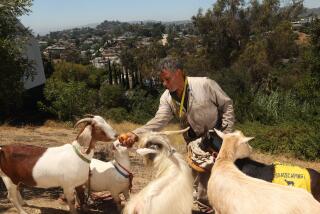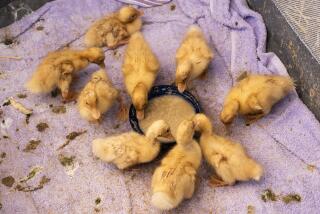The Rescuers
- Share via
ORLAND, Calif. — It’s 3 a.m. and Lorri and Gene Bauston hear banging and thumping outside. They jump from their bed and run to the window. Lit by the moon are 70 to 80 sheep milling about their home, the rams scraping and rubbing their horns on the side of the house.
Welcome to sheep central.
“The rams love butting up against everything. They have these big racks of horns. Now we have horn rub marks all against our house,” Gene Bauston says.
Farm Sanctuary, which the young couple founded and now run in both Northern California and upstate New York, has maneuvered to rescue 200 or so Santa Cruz Island sheep.
In the fall, the creatures were snapped from the impending jaws of slaughter or servitude at a breeding farm after the National Park Service had them shipped off the island. The sheep have nearly nibbled the native plants into annihilation.
Another evacuation of the feral sheep reached the mainland last week, and more such efforts are planned throughout the summer.
So the sheep have been rescued. Now what?
For Farm Sanctuary, the 65,000-member bicoastal organization whose mission is to rescue and provide sanctuary, protection or new homes for helpless farm animals, the hard part has just begun. First comes the housing.
“When I saw those sheep outside my door in the middle of the night, I knew that those sheep definitely needed their own home,” Lorri Bauston says. “Right away.”
“Their own home,” in farm talk, means a dedicated barn for the couple of hundred new additions to the Northern California sanctuary--already home to 500 animals rescued from Dumpsters, slaughterhouses, highways or picked up after emergency call-ins.
The sanctuary isn’t exactly tight for space. There are 300 acres of rolling green hills in lush country north of San Francisco on the eastern foothills of California’s coastal range. Dotting the hillside are Farm Sanctuary’s six barns and the Bauston homestead, as well as the barn being erected for the sheep and another building being constructed as the new visitors center. It’s a pastoral scene out of some long ago jigsaw puzzle pictorial, in which cows, chickens, goats, turkeys and lambs dot a verdant landscape under blue skies with white puffy clouds.
And now, the bleating of 207 sheep. (There were 205 rescued, but two pregnant ewes went unnoticed among the herd, presenting the farm with two newborns.)
The Baustons have jumped into high gear to raise funds for the added expenses. The new barn, for which the foundation was just prepared, will be ready by late summer, at a cost of $70,000. They recently neutered the herd: a cost of $6,000. Then there’s the food. Their national membership received an alert-mailer in early May about the sheep, the new barn and the Adopt-an-Animal program that the Baustons inaugurated about five years ago.
So far, Farm Sanctuary’s biggest adoption success story is Adopt-a-Turkey, with more than 5,000 adoptions over the years from individuals, classrooms and corporate sponsorships. For turkeys, the big season, of course, is the weeks leading up to Thanksgiving, when vegetarians and guilty carnivores have turkey on their minds.
But now the push is for sheep. With a similar setup for them, participants can select the animal of their choice from a flier that features an array of sheep, their names and histories. They then pay $20 per month and receive a certificate of adoption and a photograph of their foundling.
“Let’s see, there’s lovely little Juanita,” says Lorri. “She’s just drop-dead gorgeous, as they say.” She laughs. “And Heathcliff. What a brave little story. He came in with a broken leg. It had never healed properly, so infection set in. Unfortunately, we had to remove the leg.” But the story has a happy ending. “For the first time in his little life, he can now keep up with the other sheep,” she says.
The sheep are also available for full-fledged adoptions. “But they need a farm-like environment, with a fenced area and some pasture,” explains Lorri, 38, who looks after the animal care while her husband, 35, attends to the public campaign and outreach.
As of the end of May, the mailer has yielded $11,500 in emergency donations. “That’s good, but it’s only 10% of what we need for the sheep,” says Gene, undaunted even though the building is slated for a late-summer completion.
*
The sheep situation on Santa Cruz Island remains fluid. Once a tangled web of shared ownership among the federal government, the nonprofit Nature Conservancy and private parties, a congressional act in early 1997 eliminated the remaining private ownership of the island, converting it to National Park Service land. The park service began corralling and shipping groups of sheep to the mainland almost immediately, though many remain on the island. Once shipped to Port Hueneme, the sheep are trucked to Buellton, where they are housed in a livestock market to await their fate.
“Some of the sheep are sent to slaughter. Others are sold for breeding. And we’ve donated some to Farm Sanctuary as well as Discipline International, an organization that runs a ranch in Oregon, which serves as a halfway house for recovering alcoholics who come to work,” says Andrea Gherini, offspring of the ranching family that held title to Santa Cruz Island from the mid-1800s.
There are still vast herds of sheep on the island, “but we don’t know exactly how many,” says Ventura County Parks Service spokeswoman Carol Spiers. “After the winter rains, we know there are at least 1,000, plus they’ve been breeding.”
The Baustons are prepared to go into action when the next round of sheep is organized for shipment to the mainland. It’s an arduous process, for sheep and human. “It was a pretty dramatic scene, the two shipments that I went to pick up in Buellton. Backing up the transport trailer to the loading chute, it was the middle of winter, chasing the sheep up into the truck,” remembers Diane Miller, the farm’s shelter manager, who drove the 20-foot trailer. “It was stressful. The sheep panic--they were really afraid.”
And then the 600-mile drive back to the farm. “When I arrived at 10 p.m., everybody came out in their PJs to help with the unloading. It was pretty great to watch the sheep come bounding out of the truck. The stark contrast between the stockyard where they were and our big, spacious rescue barn full of clean straw,” says the young animal enthusiast. And over the next few days the sheep were slowly acclimated. “We tried to keep a low profile with them: feeding them, cleaning the barn, but basically staying away so they could get used to being home with the least amount of stress.”
Their new home is a far cry from the bleak situation that recently existed on Santa Cruz Island, where, to thin the herd, hunters who were willing to pay $500 a pop were allowed to shoot into the herd to nab a ram’s head trophy. Shooting was often done from helicopters with rapid-fire sniping.
Gherini visited after one of the shooting sprees, where thousands of sheep lay dead on the hillsides. “It was the eeriest feeling because there were no animals anywhere. It was stone quiet. And there were thousands of flies, in the air and all over the carcasses,” says the fourth-generation rancher. “It was horrifying.”
The public outcry that followed the aerial shooting of the feral sheep spurred the government to find an alternative solution to eradicating the island population. The Baustons stepped in and met with park and government officials.
“It’s still a bittersweet story,” Gene says. “On the one hand, we stopped them from being sprayed by machine-gun fire . . . where a lot of the animals didn’t die until a few days later, and suffered, mothers being killed and babies running frantically around. But sheep are still being slaughtered and sent to be used for commercial purposes.”
The situation involving the sheep, the land, the government and the public clearly needs a resolution. “A healing solution is needed,” Gherini says. She wants to give these sheep some peace. “These animals have been wild their whole lives. We’re donating them so that they will not be slaughtered. They’ll be able to live out their lives. Hopefully, something positive can come from this traumatic episode.”
And the sheep have become part of an extended family of humans and nonhumans. “The little lambs are bottle-fed; they’re literally like puppies,” Miller says. “They follow you around. Two lambs in particular, Juanita and Zoe, would rather be with people than other sheep. And Juanita just wants to be carried around. She’ll paw at your leg. They all know their names. You call them out in the pasture and they respond.”
And lambs, like elephants and other herding animals, protect their own. Says Lorri: “You’ll see a leader in every group, and when there is a sense of danger, the leader moves and the rest follow, and they’ll circle around the lambs as well.”
With the bleating of more than 200 sheep in the background, and the gravel foundation just being prepared in anticipation of a house to shelter them, the Baustons are undaunted by a call from down south. “We’ll be right there. We’ll take as many sheep as they want to give us. We just want to give them their lives and their freedom. We’ll find the space.”
*
For information on sponsoring an animal, call (888) SPONSOR. Or write to Farm Sanctuary, P.O. Box 1065, Orland, CA 95963.
More to Read
Sign up for Essential California
The most important California stories and recommendations in your inbox every morning.
You may occasionally receive promotional content from the Los Angeles Times.










